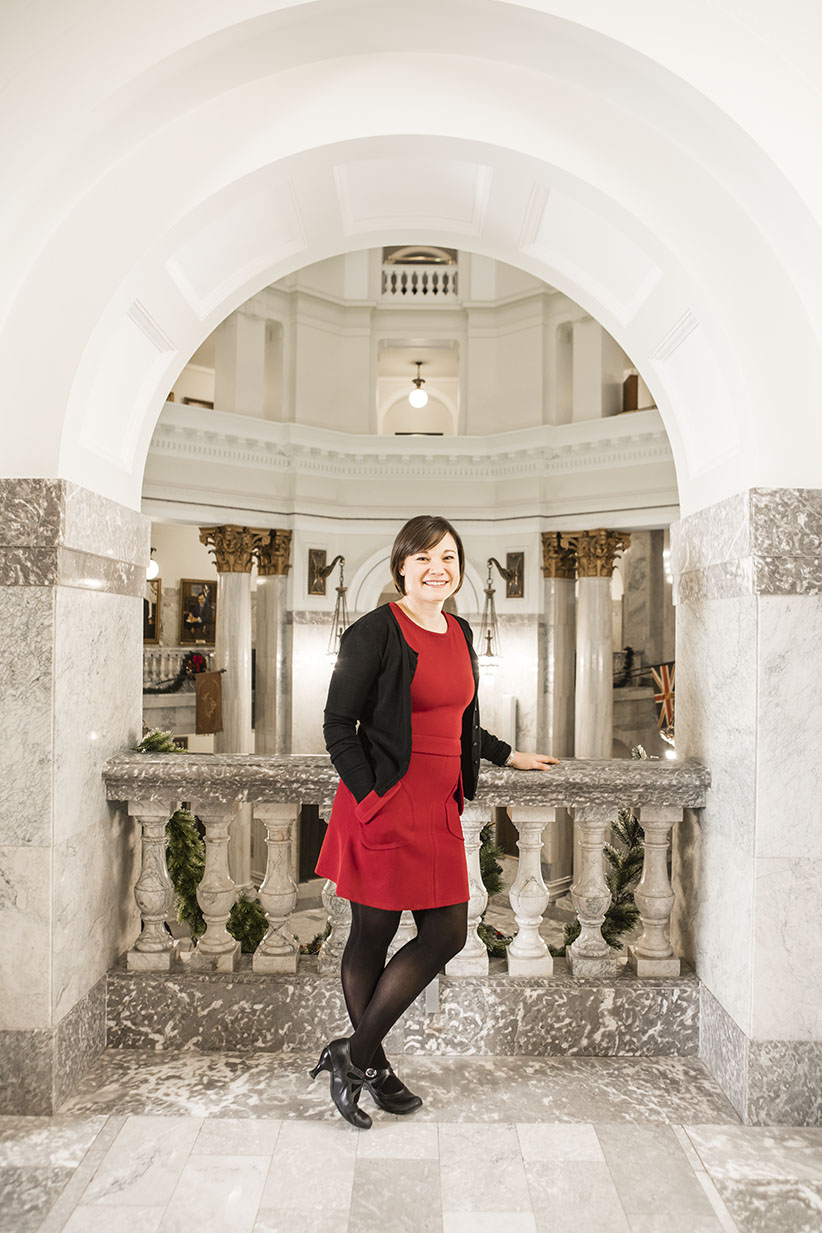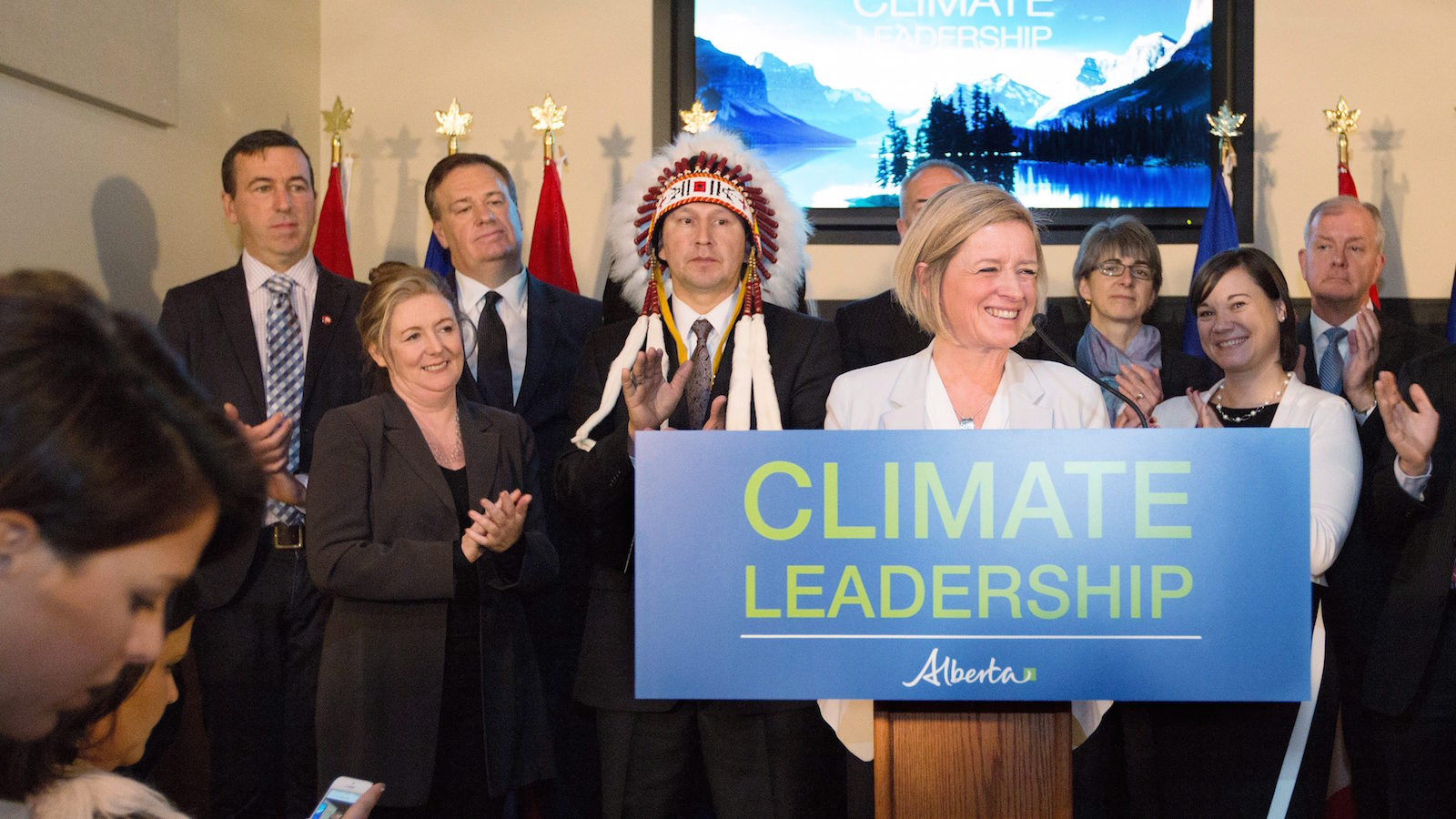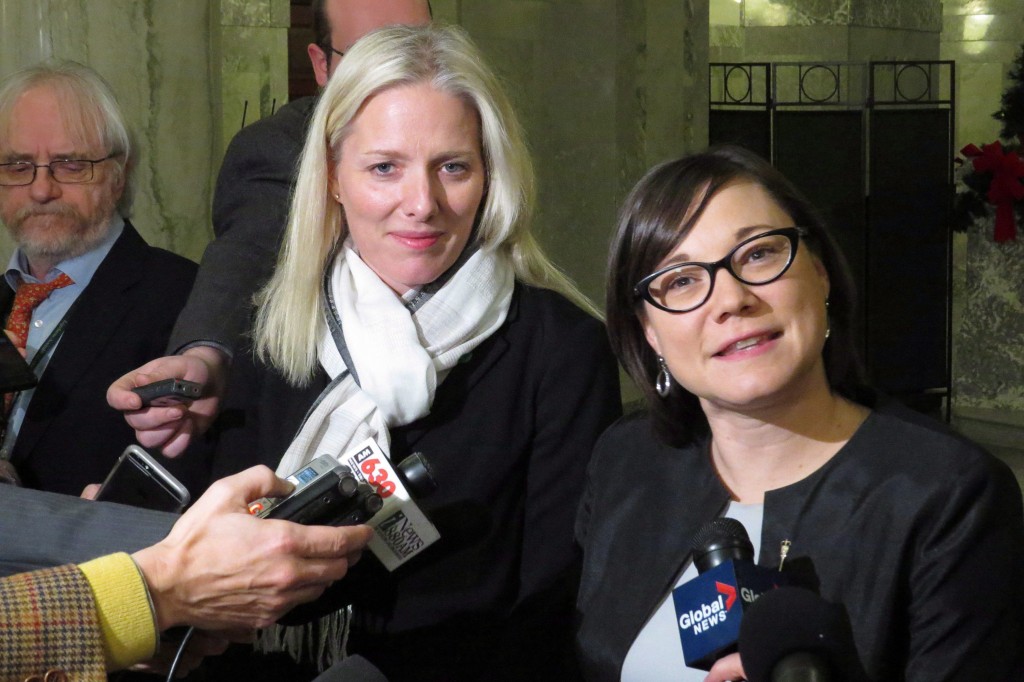Shannon Phillips: Alberta’s Minister of hard hits
How a former activist and roller derby player is changing Alberta’s—and Canada’s—climate change record
Shannon Phillips was recently elected as an MLA to the Alberta legislature and appointed Alberta’s Minister of Environment and Parks. (Photograph by Daniel Wood)
Share

In a small Paris conference room, Shannon Phillips sat in awe among international corporate executives, environmental foundation leaders and fellow provincial environment ministers as California Governor Jerry Brown hosted a panel. He was first governor in 1975, the year Phillips was born. The way he waxed on confidently about emissions and efficiency, Phillips thought: it’s in his DNA. “To watch him operate was a sort of master class in progressive politics,” she says.
A United Nations climate change adviser, apparently mindful of gender balance at the microphone, invited Alberta’s environment minister to speak about her province’s new plan. Phillips, barely six months into her political career, rhymed off the basics: an Alberta-wide carbon tax, phasing out all coal power, a cap on oil sands emissions. “ ‘Well, I think that deserves a round of applause,’ ” Phillips recalls the adviser saying. “And there was a round of applause. Which was a really great moment to see that what we did actually does move the goalposts and is a model for other jurisdictions.”
When the Tories ran things in Alberta, much of the world was not clapping. As the oil sands expanded along with their dirty reputation, lack of strong provincial action and federal acquiescence made Canada a perennial “fossil of the day” joke. In November, Rachel Notley’s NDP bid to reverse that with one of Confederation’s most comprehensive carbon plans, and what will be the most dramatic policy shift of this new government’s first term unless it transfers control of Banff and the Rockies to British Columbia by 2019.
It became clear that Notley wanted a fresh approach when she named her environment minister, which in an activist government in a petroleum province becomes one of Canada’s top political jobs. Into a neophyte cabinet light on executive experience (but big on ideals), she named a tenacious social democrat with roots in activism, feminism and organized labour, and whose toughness follows her outside the office. It has to, when you’re determined to succeed as a roller-derby player and single mom of two.

Phillips wears her progressive streak on her team jersey—her derby name is Gnome Stompsky (she decided that riff on U.S. writer Noam Chomsky and her own short stature was funnier than “Smack Layton”)—and on her office walls. It took her several months as minister to get around to replacing the dour landscapes her Tory predecessor had. Phillips eventually decorated with bright paintings by Indigenous Albertans like Alex Janvier and Aaron Paquette (a federal NDP candidate) as well as posters: an Obama-style Jack Layton “Hope” graphic in orange and green, and a sepia-toned image of two young New York girls wearing roller skates and sashes that read “Don’t be a scab.” Beneath that 1916 New York image is the red logo of Industrial Workers of the World (IWW).
In an interview, Phillips says she never believed Albertans were as conservative as the myths or previous governments made them out to be—though they may not all be IWW fans, mind you—and the May 5 election bolstered that view. Yet she also recognizes how reliant her province and government is on petroleum wealth. So she vies to fill what she has called the “prairie pragmatist” NDP role, having to rebuff both environmentalists’ urges to do even more, and some energy-sector urging to do not much more than the status quo.
But she’s on more common ground than she expected. By the time she got her Alberta Environment briefing binders, oil sands executives were already months into meetings with environmentalists on a new way forward, and would soon propose the firm emissions cap to Phillips and Notley. “We know we need to do better,” Phillips told Maclean’s in July. “Industry knows we need to do better, civil society knows we need to do better and Canadians and the international community understand that. And the previous government’s approach was to double down on a message that was not substantive and that did not ring true to the people to whom they were speaking.”

Oil executives and environmental group leaders stood together on stage at Edmonton’s science museum in November, as the NDP launched its climate plan—the visual embodiment of what Phillips had said months earlier. As Notley trumpeted “the day we do our part,” she also praised her environment minister “for her passion, her dedication and her commitment on this issue. Shannon, you have inspired us all.”
Phillips, standing behind Notley, was visibly moved, barely holding back tears.
The Wildrose opposition swiftly derided the promised $30-per-tonne carbon tax as a “tax on everything” and not a policy the NDP had campaigned on. Quite true—the party was decidedly vague on much of its climate-change platform, except for a promise to “take leadership.” The government hired University of Alberta energy economist Andrew Leach to fill in those large blanks. Leach, a Maclean’s contributor, knew Phillips through Twitter debates before she was in politics, when she was a policy analyst for the Alberta Federation of Labour. She brought that same “challenge-driven, combative” approach as minister, Leach says. “What I enjoyed most about working with her, and it’s the same with the premier, is this push, this litigation of ideas. ‘Convince me,’ ‘Argue with me,’ the idea that even if she might like something, she’s still going to ask 20 questions. If she doesn’t like something, she’s going to tell you, which is refreshing.” Phillips also recalls fondly the “creative tension” with Leach’s review panel.
Related: What we know—and don’t know—about Alberta’s climate plan
Phillips first learned how the Alberta legislature worked a decade ago, as a communications aide for the NDP’s four-member caucus in the waning days of premier Ralph Klein. She brings some of that opposition feistiness to the government benches. Before Halloween, she wore an orange blouse and black cardigan with the skull logo of punk band the Misfits, explaining in question period it was “in homage to the fairly scary Wildrose policies on the environment.” As minister of status of women (a portfolio she holds in addition to climate), she defended her department’s budget by calling the last Tory’s efforts on the file “deplorable” and “disgusting.” She apologized to Sandra Jansen, that Tory minister, via text message. “ ‘I apologize that it sounded like I was impugning your work.’ Well, you were,” says Jansen, reading the message off her phone. “She just operates from a really aggressive place. On women’s issues, I think you want to be a consensus-builder.”
Phillips, who chaired an agency for low-income women in her native Lethbridge, has vowed to “build feminism in Alberta” as head of Canada’s first stand-alone provincial ministry for women’s issues. To her, that means pushing for a better government approach to sexual violence and a voice for Indigenous women, and eventually to tackle economic inequality and child care. “These are long-term conversations that take a tremendous amount of resources, resources we may not have right now,” she says.

Roller derby, to her, is the Western world’s first feminist sport, she once wrote on a teammate’s blog. That was part of the appeal when she joined four years ago. Also, she couldn’t find a women’s hockey beer league in Lethbridge. She first watched the full-contact sport while pregnant in 2011 with her youngest son; she began on roller skates weeks after Hudson was born, and joined the Deathbridge Derby Dames soon after. Her derby number, 4746, reflects her vote total the first time she ran and lost for Alberta’s NDP in 2012.
She specializes as a blocker in the complicated sport, letting her team’s “jammers” score, says Dames team leader Martina Emard (a.k.a. Cherri Blaster). “I would call her fierce,” Emard says. “Stompsky’s very good at picking her targets, whether another blocker for an offensive hit, or another jammer for a defensive hit. She’s very good at honing in on what needs to be done, and does it.”
Despite juggling two ministries in Edmonton and two children in Lethbridge, Phillips still tries to find time for a practice or scrimmage once a week. To her, the Dames are like family, part of her community. “And no one there cares what my job is, which I like,” she says.
Politics doesn’t run in Phillips’s family. In fact, she was the one who pushed her clan into politics—she persuaded her younger sister and mother to run as federal NDP candidates in Spruce Grove, the town west of Edmonton where she grew up (they both lost). She could name every Mulroney cabinet minister as an 11-year-old, and organized her first protest at 17, successfully fighting Spruce Grove’s curfew imposed on teenagers that “feels like a police state,” she said then.
“As I grew older, I became increasingly impatient with wealth inequality, with inequality between women and men, with racial discrimination, with our colonial heritage—all the various ways I look at it and think: ‘We can do better,’ ” she says. “And the excuses for why we couldn’t do better were increasingly thin.”
Phillips was in the tear-gas clouds of the 2001 Quebec City protests against the Summit of the Americas, and for years co-hosted a campus radio show, “Rise Up: Radio Free Edmonton,” with Mike Hudema, Alberta’s most prolifically theatrical activist. While working together at the University of Alberta’s student union, Phillips got co-writing credit with Hudema for his 2004 activism guidebook, “An Action a Day Keeps Global Capitalism Away.” The Wildrose had a field day with this bit of Phillips history during question period, but Hudema and Phillips both say her contributions were minimal. Hudema now deals with her as a Greenpeace climate campaigner. “Shannon has always had more of an inside mentality, working within government, working within institutions,” Hudema says.
The institution Phillips now helps lead oversees a petro-dependent economy, where her premier advocates for the Energy East oil sands pipeline, which environmental leaders—even some who stood with Shell and Suncor on stage in November—say is incompatible with the climate-change fight.
Related: Our interview with Shell Canada’s president on Alberta’s plan
On her last full day at the Paris conference, as it became clear Canada and the world would pledge to prevent global warming by 1.5° C, she faced calls for Alberta to leave oil from the oil sands in the ground. The thousands of jobs Alberta lost in 2015, Phillips replied, came because low crude prices were keeping more energy in the ground. And the deficit that has wrought makes it harder to improve schools and hospitals. So there are consequences to “leaving it in the ground” before a different economy is in place, she said.
Alberta’s plan will not, by 2030, bring emissions down below 2013 levels, let alone come close to the path toward the 1.5° C target, leaving greater reductions for other provinces. But it is designed to finally send the emissions curve downward next decade, requiring major adjustments for Alberta consumers and its key industries. Call it inadequate, or call it radical. Phillips calls it “honest steps,” and part of that is acknowledging that Alberta isn’t positioned to do what other provinces or countries can. But she’s determined her government must do something serious.
“There’s a whole global economy moving forward and changing the way it looks at carbon emissions, she says. “So we only have two choices to make. We can be part of that, or we can choose to reject that and engage in angry navel-gazing as we do so. That’s not our approach.”